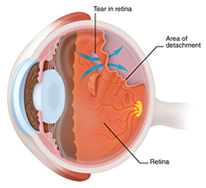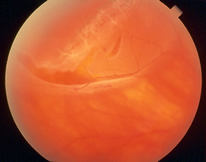Retinal Detachment

Retinal Detachment
Retinal detachment occurs when the retina of the eye is pulled away from the underlying tissue to which it is attached. A retinal detachment is a medical emergency which can lead to permanent blindness if left untreated. In most cases, the detachment is a slowly progressing issue which must be treated once symptoms are realized. In some cases, a detachment occurs due to a trauma which causes a tear in the retina, allowing fluid to enter from the vitreous and detach the retinal tissue.
Causes of a Retinal Detachment
Retinal detachment is usually spontaneous but may also follow other eye surgery. A Vitreous detachment may cause a retinal tear and begin the detachment process. Risk factors for a retinal detachment may be as follows:
- Nearsightedness
- A retinal tear
- Family history of retinal detachment
- Cataract surgery
- Trauma
Symptoms of a Retinal Detachment
Symptoms of retinal detachment may progress slowly or rapidly, but both should be reported to a medical doctor as soon as possible so as to minimize the risk of vision loss. Some of the symptoms of a retinal detachment include:
- A sudden decrease in visual acuity
- A sudden increase in the amount of "floaters" in vision
- Bright flashes in the periphery
- An unnatural "curving" of straight lines
- Loss of central vision
- A dense shadow affecting part of the visual field
The patient should be taken to an emergency room as quickly as possible.
Diagnosis of a Retinal Detachment

Retinal Detachment
Diagnosis of a retinal detachment is made after a thorough medical eye examination and the performance of the following diagnostic tests:
- Dilated eye examination
- Ultrasound of the eye
- Fundus photography of the retina
- Visual acuity test
- Slit-lamp examination
Treatment of a Retinal Detachment
A retinal detachment may be treated in many ways, which may include one or both of the following:
- Cryotherapy
- Laser photocoagulation
- Pneumatic retinopexy
- Scleral buckle
- Vitrectomy
Most surgeries to repair a retinal detachment have a success rate of over 85%. In some cases, a second procedure will need to be performed. After a successful procedure, vision will take time to improve but may not return to previous levels of acuity.

